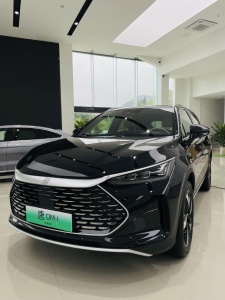Which one is more worth starting, Tiggo 9C-DM or Tang DM-i
With the increase in families with two children, 150,000 - 200,000-class hybrid 7-seat SUVs have become the focus of the just-needed market. For example, the Chery Tiggo 9C-DM and BYD Tang DM-i, as representatives of the two major domestic technology-oriented hybrid SUVs, both have attracted the attention of many consumers.

So when faced with these two "Science and Technology Men" models, how should we choose? Which one is more worth it for you?
The core value of hybrid technology lies in how to balance power performance and fuel economy. The Tiggo 9C-DM and Tang DM-i have adopted completely different technical routes in this regard. Understanding the differences between these two systems can help us find a more suitable model for ourselves.
First of all, in terms of pure electric endurance, the Tang DM-i is 115 kilometers under the CLTC standard, while the Tiggo 9C-DM is 106 kilometers. For home users with daily commuting distances of less than 50 kilometers and household charging piles, both vehicles can use electricity for a long time, greatly reducing fuel consumption. When it comes to long-distance travel, the comprehensive cruising range of the Tiggo 9C-DM reaches more than 1400 kilometers, and the Tang DM-i is about 1150 kilometers.
In terms of fuel consumption performance, the comprehensive fuel consumption of the two vehicles per 100 kilometers is controlled within 6L. The standard WLTC feed fuel consumption of the Tiggo 9C-DM is 5.65L/100km, which is slightly better than the Tang DM-i's 5.75L/100km. The comprehensive cruising range, the Tiggo 9C-DM has reached more than 1400km, while the Tang DM-i is about 1150km.
The difference behind this may be that the two adopt different hybrid architectures. The Tiggo 9C-DM is equipped with a 3-speed DHT gearbox, while the Tang DM-i adopts a single-speed E-CVT structure. The multi-gear design allows the Tiggo 9C-DM engine to maintain the optimal working range over a wider speed range. Especially during high-speed cruising, the engine speed can be significantly reduced, resulting in better high-speed fuel consumption performance.
Three-speed DHT gearbox equipped with Tiggo C-DM
Therefore, for families who often need long-distance self-driving, the fuel consumption advantage of the Tiggo 9C-DM may be more obvious. On the contrary, if it is only driven in an Urban area for a long time, there will be little difference in fuel consumption between the two.
In terms of power performance, Tang DM-i relies on its more powerful drive motor to accelerate for 7.5 seconds at 0-100km/h, which is more than 1 second faster than the Tiggo 9C-DM's 8.8 seconds.
However, the three-speed DHT gearbox equipped with the Tiggo 9C-DM can allow the engine to participate in direct drive more frequently, and work together with the motor to make it have excellent re-acceleration ability in the medium and high speed segments. It has greater confidence when overtaking at high speeds. Engine noise control will also be better.
At the same time, the Tiggo 9C-DM uses ventilated disc brakes on the rear wheels. Compared with Tang DM-i's ordinary disc brakes, it has better heat dissipation performance and is less prone to thermal decay during long downhill or continuous intense driving. phenomenon.
Therefore, for families who like to travel by car, travel frequently long distances or drive frequently in mountainous areas, the Tiggo 9C-DM will perform better in terms of power and safety margins.
For home users who choose a 7-seat SUV, the rationality and flexibility of the interior spatial layout are often more important than the mere size parameters.
Although the Tiggo 9C-DM and Tang DM-i have the same wheelbase, both of which are 2820mm, they present different design concepts in terms of space utilization, seat design and storage flexibility.
In terms of body size, the Tang DM-i has a slight advantage in length, 50mm longer than the Tiggo 9C-DM. In terms of width and height, Tang DM-i is also slightly ahead of the Tiggo 9C-DM.
Thanks to the longer body, under the normal state when the third row of seats is upright, the trunk volume of the Tang DM-i is 235L, which is indeed more spacious than the 200L of the Tiggo 9C-DM and can accommodate more. A standard boarding box.

However, after the rear seats are all lowered, the trunk space of the Tiggo 9C-DM can be expanded to 2021L, which is nearly 400L more than the Tang DM-i, and can accommodate more camping equipment or large items. This is a more flexible Tiggo 9 may be more practical for families who need to occasionally carry large items or prefer to self-drive camping.
Looking at the seat configuration that most affects the comfort of long-distance travel, we select the two cars with the closest guide prices for comparison.
The Tiggo 9C-DM is significantly more luxurious in front seat configuration. The main driver's seat not only supports heating and ventilation functions, but also massage functions and lumbar support adjustment. The co-driver is equipped with what is called a zero-gravity queen seat. With electric leg rest and boss button, family members can easily adjust to a semi-reclining position, effectively relieving the fatigue of long-distance rides.
In contrast, the front seats of the Tang DM-i model of the same price range only provide basic heating/ventilation functions, which is slightly simple in terms of comfort configuration.
In terms of the second and third rows of experience, the Tiggo 9C-DM also has an additional second row seat heating function. The third row of seats supports backrest angle adjustment. It is more comfortable for the elderly to sit in the second row in winter, and for children to sit in the third row. It is also easier to find a comfortable sleeping position. Overall, the comfort configuration of the Tiggo 9C-DM can better take care of the needs of the whole family.
In addition, the Tiggo 9C-DM is equipped with an active noise reduction system, which can effectively block wind noise and road noise during high-speed cruising, creating a quieter riding environment for the whole family. Tang DM-i's advantageous configuration is mainly the soft and hard adjustment of the suspension. The suspension can be adjusted to adapt the vehicle to different road conditions.
Intelligent configuration is the key configuration for young families when buying a car, and it is also the focus of building these two cars.
Let's first look at the smart cockpit. The Tiggo 9C-DM is equipped with a 24.6-inch curved screen driven by a Qualcomm Snapdragon 8155 chip. The system supports wireless CarPlay and HUAWEI HiCar. It is very friendly to mobile phone parties. Whether it is iOS or Huawei devices, it can achieve seamless connection and is very easy to use.
In contrast, the Tang DM-i adopts a 15.6-inch rotating central control large screen design. The screen can automatically rotate into horizontal screen or portrait screen mode according to the application scenario. The user experience is a bit like a Taiwan University tablet, and the system fluency is also remarkable.
However, the car system does not support CarPlay and HiCar, which is a pity for users who are accustomed to using the mobile phone mapping function. It may take an adjustment period.
In terms of parking assistance, both vehicles provide 360-degree panoramic images and automatic parking functions. For a large 7-seat SUV, these configurations can significantly reduce the difficulty of parking, especially in crowded shopping malls underground garages or roadside parking. Especially practical when parallel parking.
It can be seen that in terms of smart technology, Tang DM-i has a slight advantage in advanced driving assistance functions, while Tiggo 9C-DM is better in mobile phone interconnection.
Through comparison, we can see that these two cars are very excellent in terms of overall performance in terms of fuel consumption, power, space and intelligence. Thanks to the only 3-gear DHT in its class, the Tiggo 9C-DM will have more advantages in fuel consumption and power in some scenarios, such as high-speed scenarios. At the same time, the overall comfort configuration of the Tiggo 9C-DM is also higher in the same price range, while Tang DM-i has an advantage in driving assistance functions.
After the Tiggo 9C-DM market terminal discount combined with replacement subsidies, the actual starting price of the top allocation is close to 150,000 yuan. However, the current preferential range of Tang DM-i is relatively limited. At the same time, compared with Tang DM-i's 6-year or 150,000-kilometer vehicle warranty, Tiggo 9C-DM provides the first vehicle owner with a lifetime warranty service, which also saves users from worries.
So on the whole, if you plan to buy a hybrid 7-seat SUV for just over 150,000 yuan, which is suitable for the whole family, the Tiggo 9C-DM will obviously be able to obtain a higher configuration at a lower price. If the budget is more abundant, Tang DM-i is also a good choice.

